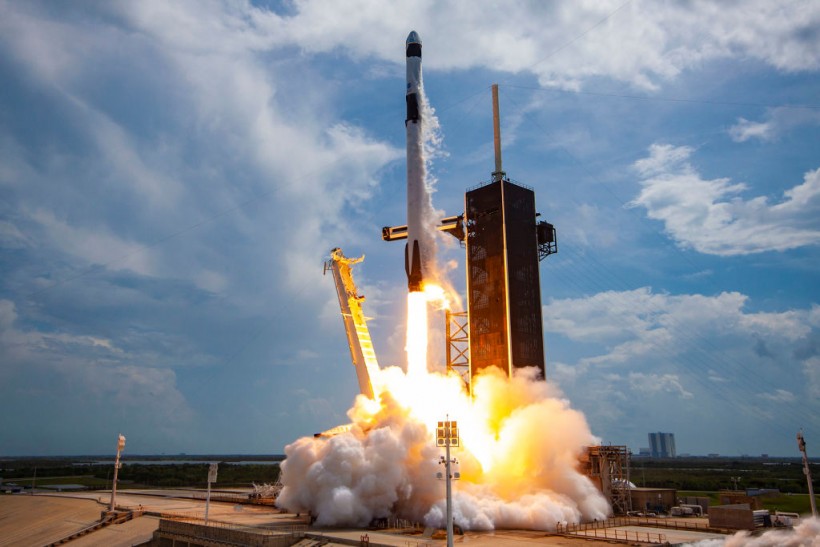For the previous three days, Elon Musk's SpaceX has been trying to put an Italian surveillance satellite into orbit, but a cruise ship caused another delay to Falcon 9's launching from Cape Canaveral Space Force Station.
The company's launch director called a halt to the SpaceX rocket's planned liftoff from Florida on Sunday with just over 30 seconds to go. According to Forbes, all seafarers are notified in advance of launches from Cape Canaveral. So they know where and when to avoid particular seas.
However, reports said a cruise ship got into the "no-go zone" downrange of Cape Canaveral and couldn't get out of the way in time for the Falcon 9 to reach its window.
The next launch attempt is slated for Monday at 6:11 p.m. EST, according to SpaceX.
Standing down from today's launch of COSMO-SkyMed Second Generation FM2 due to ship in the hazard area; team is setting up for next opportunity tomorrow, January 31 at 6:11 p.m. EST
— SpaceX (@SpaceX) January 30, 2022
SpaceX Scrubs Falcon 9 Launch Due to
During today's launch attempt webcast (via Space.com), SpaceX production manager Jessie Anderson stated that the spacecraft and cargo are still in good shape. Aside from the range, he said everything was looking good for a timely liftoff today.
This was the fourth day in a row that SpaceX had to cancel a CSG-2 launch attempt. The first three scrubs were due to inclement weather, but it cooperated today. According to Anderson, the weather forecast for tomorrow's attempt also seems promising.
The Italian Space Agency, the Italian Ministry of Defense, and the Italian Ministry of Education, Universities, and Scientific Research collaborate on the Cosmo-SkyMed Second Generation initiative. The network consists of two satellites that use synthetic aperture radar to examine our globe.

In this SpaceX handout image, a Falcon 9 rocket carrying the company's Crew Dragon spacecraft launches on the Demo-2 mission to the International Space Station with NASA astronauts Robert Behnken and Douglas Hurley onboard at Launch Complex 39A May 30, 2020, at the Kennedy Space Center, Florida.
ALSO READ: SpaceX Wants to Launch Rockets Weekly to Achieve Elon Musk's Goal of Having 52 Missions in 2022
The first CSG vessel was launched into orbit from French Guiana in December 2019 on an Arianespace Soyuz rocket. That satellite orbits Earth at 620 kilometers (385 miles) altitude over the poles, the same orbit that CSG-2 will take when it finally lifts off.
About Falcon 9 Rocket
As previously stated, SpaceX will launch an Earth observation satellite into orbit using one of its Falcon 9 rockets from Complex 40 at Cape Canaveral Space Force Station. The mission will bring a COSMO-SkyMed Second Generation 2 satellite that will be placed to the satellite network for the Italian Space Agency.
Various rocket elements are re-used from prior missions, as is customary for SpaceX. According to SpaceX, the Falcon 9 first stage rocket used previously launched Arabsat-6A and STP-2.
Digital Trends said Falcon 9 would return to Earth after stage separation and a touchdown on Landing Zone 1 (LZ-1) at Cape Canaveral Space Force Station.
The fairings supporting this operation had previously supported Transporter-1, Transporter-2, and one Starlink mission, while the other half had previously supported SAOCOM 1B, Transporter-2, and one Starlink mission.
How to Watch Launch
SpaceX will broadcast the launch live. Final launch preparations, liftoff, ascent, first stage separation, second stage ignition, fairing deployment, and payload separation will all be covered in the live stream. It will also display the first stage's entry burn and catching.
Coverage begins 15 minutes before the start of the event. You may watch the webcast by going to SpaceX's YouTube website or checking the video below.
RELATED ARTICLE: Falcon 9 Rocket's Second Stage Will Likely Impact Moon's Equator After 7 Years of Floating Through Space
Check out more news and information on SpaceX in Science Times.



![Earth's Quasi-Moon Kamo‘oalewa Could Originate From Lunar Surface Not Asteroid Belt [Study]](https://1721181113.rsc.cdn77.org/data/thumbs/full/53275/89/56/50/40/earths-quasi-moon-kamo-oalewa-could-originate-from-lunar-surface-not-asteroid-belt-study.png)










